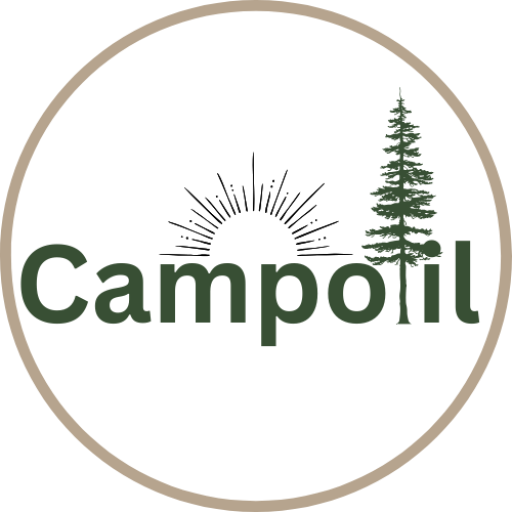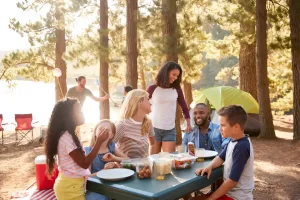Introduction
The first time I took my kids camping, I thought I had made a huge mistake. My six-year-old daughter was crying because a bug landed on her sleeping bag, my four-year-old son had already covered himself in dirt from head to toe, and I realized I’d forgotten to pack enough snacks for the weekend. As the sun began to set over Yellowstone National Park, I wondered if we should just pack up and head home.
But then something magical happened. As darkness fell, we gathered around the campfire. The kids stopped complaining and stared in wonder at the stars—more stars than they’d ever seen in our suburban neighborhood. My son pointed excitedly at the Milky Way while my daughter roasted the perfect marshmallow for her s’more. In that moment, I knew all the chaos was worth it.
According to the 2023 North American Camping Report, family camping trips increased by 18% over the past five years, with more than 40 million American families heading outdoors annually. It’s no surprise why—outdoor adventures offer kids a chance to disconnect from screens and reconnect with nature and family.
The truth is, camping with kids can be one of the most rewarding family experiences you’ll ever have—if you plan properly and keep your expectations realistic. In this guide, I’ll walk you through everything you need to know to make your family camping trip a success: essential preparation steps before you go, helpful tips while you’re at the campsite, and how to reflect on your experience afterward to make each trip better than the last.
Let’s transform your family camping dreams into stress-free reality!
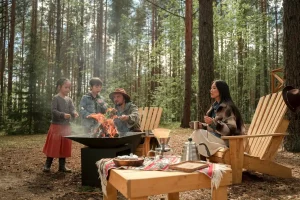
The Allure of Camping with Kids: Pros and Benefits
Nature Immersion and Education
When was the last time your child spent a whole day without looking at a screen? In our digital world, camping with kids offers a rare chance to disconnect from technology and reconnect with nature. At campsites like Grand Canyon National Park, children can explore a world beyond pixels and notifications.
During our last camping trip to Acadia National Park, my kids spent hours collecting different types of leaves and trying to match them to trees using a simple field guide. My daughter, who usually struggles to focus on homework for more than 15 minutes, spent nearly two hours tracking a small group of deer through the woods, learning about their habits and habitat. These are the kinds of educational opportunities that no classroom or app can provide.
“My son identified three constellations on our first night camping. He still talks about it six months later!” – Maria, mother of two from Colorado
Strengthening Family Bonds
There’s something special about working together to set up a family tent or prepare a meal over a campfire. These shared tasks create natural opportunities for teamwork that many families miss in their busy day-to-day lives.
Why Camping Builds Stronger Families:
- No distractions from work emails or social media
- Shared challenges create lasting memories
- Natural conversations happen during hikes and around the campfire
- Everyone has a role and feels important
I remember watching my children work together to gather kindling for our fire at Shenandoah National Park. They needed to solve problems, communicate clearly, and trust each other—skills that will serve them well throughout life.
Development of Resilience and Independence
Camping helps kids develop important life skills:
- Problem-solving: When a tent stake won’t go in rocky ground, kids learn to find solutions
- Adaptability: Weather changes? Kids learn to adjust plans and expectations
- Risk assessment: Crossing a small stream or climbing a fallen tree teaches evaluating safety
- Self-reliance: Simple tasks like filling water bottles or helping with meal prep build confidence
Research from the Outdoor Education Association shows that children who regularly participate in outdoor activities score 27% higher in measures of resilience and independence compared to their peers.
Cost-Effective Vacation
Camping vs. Traditional Vacations: Cost Comparison
| Expense | 3-Day Camping Trip | 3-Day Theme Park Visit |
|---|---|---|
| Lodging | $60-150 (campsite fee) | $600-900 (hotel) |
| Food | $100-200 (groceries) | $300-500 (restaurants) |
| Activities | $0-50 (park entrance fees) | $400-800 (tickets) |
| Total | $160-400 | $1,300-2,200 |
A weekend camping trip to Mammoth Cave National Park cost our family about $275 total, including gas. Compare that to the $1,800 we spent on a similar-length trip to an indoor water park resort! Plus, camping meals can be simple and budget-friendly—hot dogs and s’mores are camping classics that kids love.
Even beyond the financial savings, the natural playground of a forest or lakeshore provides endless entertainment without the need for expensive attractions or souvenirs.
Acknowledging the Challenges: Cons and Potential Stressors
Logistical Planning and Preparation
Let’s be honest—camping with kids means bringing a lot more stuff than when you camp alone. You’ll need extra clothes, toys, snacks, and safety gear. It can feel like you’re packing for a month-long trip even if you’re just going for the weekend!
I learned this lesson the hard way during our first family camping trip to Zion National Park. I packed like we were going on a regular adult camping trip, with just the basics. By the first night, we ran out of snacks, had no extra clothes when my son fell in a puddle, and discovered I’d forgotten their special pillows that help them sleep. The result? A very long, very sleepless night for everyone.
The Family Camping Gear Reality Check:
- Solo camper: 1 backpack
- Couple: 2 backpacks + small cooler
- Family with 2 kids: Entire car trunk + roof carrier + every available space
The challenge gets even bigger when you camp in places with changing weather. At Rocky Mountain National Park, temperatures can drop 30 degrees from day to night, meaning you need both summer and fall clothes for a single weekend!
Managing Children’s Behavior and Needs
Common Camping Challenges: A Q&A Guide
Q: My child gets bored easily. How can I keep them happy at the campsite?
A: Bring camping activities like nature scavenger hunts, card games, and simple crafts. Also plan short hikes or explorations around the campsite.
Q: What about tantrums in the great outdoors?
A: Set clear expectations before the trip. Maintain regular meal and rest times. Have a quiet spot in the tent for cooling down when emotions run high.
Q: How do I handle bedtime when there’s no real “bedtime” in nature?
A: Keep a simplified version of your home routine. Bring comfort items like stuffed animals or books. Use battery-powered night lights if darkness is scary.
According to a survey by the Outdoor Family Magazine, 68% of parents say that sleep disruptions are their biggest challenge when camping with kids, followed by weather complications (54%) and keeping kids entertained (47%).
Safety Concerns and Health Considerations
Your child’s safety is always the top priority. Here are the most common concerns and how to handle them:
| Concern | Prevention | Treatment |
|---|---|---|
| Insect bites | Use kid-safe bug spray, wear long sleeves at dawn/dusk | Bring anti-itch cream and antihistamines |
| Sunburn | Apply sunscreen regularly, wear hats and sunglasses | Pack aloe vera gel for relief |
| Minor injuries | Supervise children, teach basic safety rules | Carry a complete first aid kit |
| Getting lost | Establish boundaries, use buddy system | Have kids wear whistle, teach them to stay put if lost |
When camping at Yosemite National Park last summer, I made sure to check the ranger station for any alerts about bear activity in our camping area. Different parks have different wildlife concerns—from bears at Yosemite to alligators at Everglades National Park—so always check local warnings.
Weather Dependency
Mother Nature doesn’t always cooperate with your camping plans. During our trip to Mount Rainier, we experienced all four seasons in a single day!
Case Study: Our Rainy Weekend at Olympic National Park
What Happened: Three days of non-stop rain turned our campsite into a mud pit.
How We Coped:
- Packed extra tarps to create dry spaces
- Brought board games and books for tent entertainment
- Had complete sets of dry clothes sealed in ziplock bags
- Knew where the nearest indoor attractions were located
- Maintained a positive attitude (the hardest but most important part!)
The key lesson? Always check the weather forecast before you go, but prepare for everything anyway. A good rainfly on your tent and waterproof gear can make the difference between a disaster and an adventure your kids will talk about for years.
Pre-Trip Planning and Preparation: Setting the Stage for Success
Choosing the Right Campsite
Finding the perfect spot for family camping can make or break your trip. Unlike camping solo or with adults, when kids are involved, you need to think about different things.
What to Look for in a Kid-Friendly Campsite:
- Clean bathrooms with flush toilets and hot showers
- Relatively flat terrain for easy walking
- Safe swimming areas if near water
- Distance from your parking spot to the actual campsite
- Nearby activities like hiking trails, visitor centers, or playgrounds
I’ve found that KOA campgrounds are usually a good bet for first-time family campers since they offer amenities like swimming pools, game rooms, and planned activities. State parks like Hunting Island State Park in South Carolina offer great beaches plus camping, while national forests often have more affordable options than national parks.
“We always check the reviews on The Dyrt and Campendium before booking. Other parents will tell you the real deal about how kid-friendly a place truly is.” – Tom, father of three
For beginners, I recommend developed campgrounds at places like Sequoia National Park or Lake Tahoe, where you’ll have access to restrooms and running water. As your family gains experience, you might venture to more remote spots.
Packing Essentials for Kids
The Ultimate Camping with Kids Checklist
Clothing:
- Weather-appropriate clothes (plus extras!)
- Warm pajamas (even in summer)
- Sturdy shoes/boots
- Water shoes
- Rain gear
- Sun hats
- Swimwear
Sleep Gear:
- Sleeping bags rated for the temperature
- Extra blankets
- Sleeping pads or air mattresses
- Familiar pillows or stuffed animals
- Night lights or headlamps for midnight bathroom trips
Health & Safety:
- Complete first-aid kit with kid-specific items
- Medications
- Sunscreen
- Bug spray
- Hand sanitizer
- Wet wipes (lots of them!)
- Toilet paper
My favorite piece of kid camping gear has to be headlamps with red light options. My kids love wearing them, and they’re super helpful for nighttime bathroom trips without waking everyone up with bright white light. I also never leave home without our pop-up shade tent – it creates a clean, bug-free space for babies and toddlers to play.
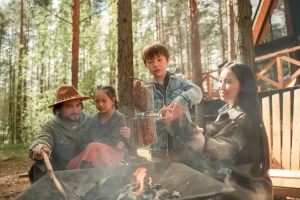
Meal Planning and Food Preparation
Hungry kids are grumpy kids, so food planning is crucial. Here are some kid-approved camping meals that are easy to prepare:
Breakfast:
- Pancakes (bring pre-made mix in a squeeze bottle)
- Instant oatmeal with dried fruits and nuts
- Breakfast burritos
- Cereal with shelf-stable milk
Lunch:
- Peanut butter and jelly sandwiches
- Wraps with deli meat and cheese
- Trail mix and fruit
- Pasta salad (made ahead)
Dinner:
- Hot dogs or burgers
- Foil packet meals
- One-pot pasta
- Tacos
When we camped at Great Smoky Mountains National Park, I learned that pre-cutting vegetables and storing ingredients in meal-specific containers saves tons of time. I also discovered that having kids help with simple cooking tasks keeps them engaged and less likely to wander off.
Safety Tip: Always store food in bear-proof containers or the trunk of your car, even in areas without bears. Raccoons, squirrels, and other critters can cause just as much trouble!
Pre-Trip Activities and Education
Building excitement before the trip helps kids adjust to the idea of sleeping outdoors. Try these preparation activities:
2 Weeks Before:
- Read books about camping and wildlife you might see
- Watch age-appropriate nature documentaries
- Look at pictures of your destination online
1 Week Before:
- Set up your tent in the backyard for a “practice camp”
- Let kids help create a packing list
- Plan and shop for meals together
The Day Before:
- Pack the car together
- Talk about campsite rules and expectations
- Check the weather forecast one last time
My kids love our pre-trip “backyard campout” tradition. We set up the tent, bring out the sleeping bags, and even cook a simple meal on our patio grill. This practice run helps little ones feel more comfortable when we reach the real campsite.
On-Site Tips for a Stress-Free Experience
Establishing a Routine and Structure
Kids thrive on routine, even in the wilderness. At Joshua Tree National Park, I noticed my kids were much happier when we kept mealtimes consistent with our schedule at home.
Sample Daily Camping Schedule:
- 7:00 AM: Wake up, bathroom trips
- 7:30 AM: Breakfast
- 9:00 AM: Morning activity (hiking, fishing, etc.)
- 12:00 PM: Lunch
- 1:00 PM: Quiet time/rest in shade
- 3:00 PM: Afternoon activity
- 5:30 PM: Help set up for dinner
- 6:00 PM: Dinner
- 7:30 PM: Campfire time (stories, s’mores)
- 8:30 PM: Bedtime routine begins
- 9:00 PM: Lights out
Having a visual schedule that kids can see helps them know what to expect next. This doesn’t mean you can’t be flexible—that’s part of the camping adventure—but a general framework helps everyone feel more secure.
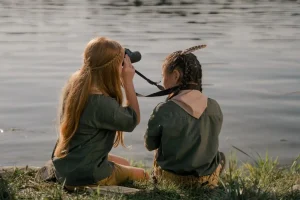
Engaging Activities and Entertainment
Age-Appropriate Camping Activities
Toddlers (1-3 years):
- Collecting “nature treasures” (with supervision)
- Splashing in shallow water
- Short walks to spot animals or plants
- Helping with simple camp tasks
Preschoolers (3-5 years):
- Nature scavenger hunts
- Rock painting
- “Fishing” in safe areas
- Simple hiking on flat trails
School-Age (6-10 years):
- Junior Ranger programs at national parks
- Learning to use a compass
- Longer hikes with interesting destinations
- Basic whittling (with supervision)
Tweens/Teens (11+ years):
- Photography challenges
- More challenging hikes
- Helping plan routes and activities
- More responsibility around camp
The Junior Ranger program at places like Grand Teton National Park provides booklets with activities kids can complete to earn a badge. It’s educational and keeps them engaged.
My family’s favorite camping game is the “Nature Connection Game.” Everyone finds one interesting thing in nature and shares three facts about it around the campfire. The most interesting fact (voted by the group) wins a small prize like choosing tomorrow’s hike or an extra s’more.
Managing Meltdowns and Challenging Behavior
Case Study: The Grand Canyon Meltdown
Situation: After a hot day of hiking at the Grand Canyon, my 7-year-old had a complete meltdown when we ran out of her favorite snack.
What Worked:
- Created a quiet, shaded space away from others
- Offered water and a small snack alternative
- Used deep breathing techniques together
- Acknowledged feelings: “I understand you’re disappointed and tired”
- Adjusted our plans for a shorter, easier activity
What I Learned: Prevention is key—pack more snacks than you think you need, schedule regular breaks, and watch for early signs of fatigue or frustration.
Remember that nature tantrums happen to every family. Kids get tired, overstimulated, or just overwhelmed by new experiences. Having a “reset plan” ready can help everyone recover faster.
Prioritizing Safety and Hygiene
Safety must always come first when camping with kids. Here’s how to keep everyone safe:
Fire Safety:
- Establish a “fire safety circle” that kids cannot enter without an adult
- Teach proper behavior around campfires
- Never leave a fire unattended
- Have water nearby for putting out fires
Water Safety:
- Use life jackets near all bodies of water
- Never leave children unattended near water
- Check for currents or underwater hazards
- Teach basic water safety rules
Wildlife Safety:
- Store food properly in wildlife-resistant containers
- Teach kids to observe animals from a distance
- Never feed wildlife
- Make noise on trails to avoid surprise encounters
Hygiene Tips:
- Create a handwashing station near your cooking area
- Use hand sanitizer before all meals
- Designate clean and dirty areas in your tent
- Change into clean clothes for sleeping
At Glacier National Park, rangers recommend carrying bear spray and teaching children to recognize animal tracks and scat. Different locations have different safety concerns, so always check with park rangers about local wildlife and weather safety.
Post-Camping Reflections and Lessons Learned
After our first family camping trip to Shenandoah National Park, we sat around our kitchen table with hot chocolate and cookies. Each person shared their favorite memory and the hardest part of the trip. My daughter loved seeing a deer up close, while my son was most proud of helping to build the fire. Both admitted they were scared during the thunderstorm our second night.
This simple post-trip discussion taught me something valuable: talking about the camping experience helps cement the good memories and turn challenges into learning opportunities.
3 Ways to Learn from Your Camping Adventures:
- Create a “What Worked/What Didn’t” List
After camping at Arches National Park, we made two columns on paper. Under “What Worked,” we wrote things like “bringing extra socks” and “flashlight games in the tent.” Under “What Didn’t,” we listed “forgetting marshmallow roasting sticks” and “not enough warm layers.” This list became our guide for the next trip. - Make a Photo Memory Book
Kids love looking at pictures of themselves being brave or having fun. These visual reminders help them connect with nature and build confidence. Our photo book from Lake Superior Provincial Park gets pulled out whenever someone feels nervous about a new adventure. - Start Planning the Next Trip
Nothing says “this was worth it” like immediately dreaming about the next camping trip. Even if there were tears and tantrums at Acadia National Park, my kids were already asking when we could go back while we were still unpacking the car!
“The dirt washes off, but the memories last forever.” – My daughter, age 8, after our muddy weekend at Great Sand Dunes National Park
Remember that even the mishaps become funny stories later on. That time we forgot tent stakes at Olympic National Park and had to improvise with sticks? Now it’s a favorite family tale about problem-solving together.
The true magic of camping with children isn’t in having a perfect, stress-free trip. It’s in the shared experiences, the challenges overcome, and the unique family bonds formed when you step away from everyday life and into nature together. So embrace the mud, the occasional tears, and the inevitable forgotten items. What your kids will remember most isn’t the perfect s’mores or the scenic vista—it’s the feeling of adventure and the time spent together.
Your family’s outdoor journey is just beginning. The woods, mountains, and lakes are waiting for you—and so are the stories you’ll tell for years to come.
Conclusion
Camping with children doesn’t have to be stressful or overwhelming. With thoughtful planning, proper preparation, plenty of flexibility, and a positive attitude, your outdoor adventures can become treasured family memories. Whether you’re setting up a tent at Yellowstone National Park or roasting marshmallows at your local state park campground, the key is to embrace both the joys and challenges of the experience.
Remember that each family camping trip gets easier as you learn what works for your unique kids. The skills they develop and the connections they make with nature will last a lifetime. So pack your family tent, gather your supplies, and head outdoors—your next great family adventure is waiting just beyond the trailhead!
What camping trip will your family plan next?
